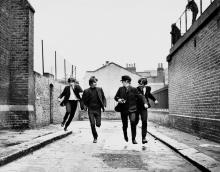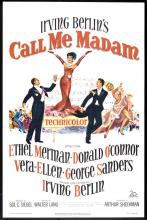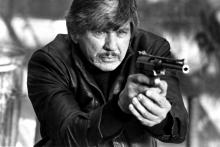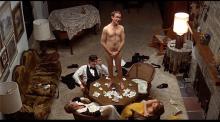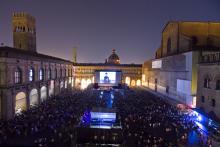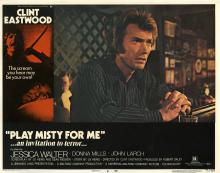This essay on Richard Lester's classic A Hard Day's Night was written by UW Cinematheque Programmer and Project Assistant Amanda McQueen. A new 4K DCP restoration of A Hard Day's Night will screen on Saturday, May 2, at 7 p.m. in our regular Cinematheque venue, 4070 Vilas Hall.
By Amanda McQueen
A Hard Day's Night holds an interesting place in the history of the film musical. On the one hand, it's simply a product of genre cycles. The concurrent rise of the teenage movie-going audience and rock 'n' roll in the mid-1950s had resulted in a steady stream of low-budget pop musicals. Spurred by the success of exploitation producer "Jungle" Sam Katzman's Rock Around the Clock (1956), starring Bill Haley and His Comets, filmmakers started churning out inexpensive vehicles to showcase contemporary musical fads, from calypso to jazz to surf rock. These musicals were almost guaranteed to turn a profit, while also offering the opportunity for ancillary revenue through soundtrack sales. A Hard Day's Night started as just another entry in this cycle.
The film was commissioned by United Artists' record division, which wanted a Beatles album to exploit in America. The lads from Liverpool were topping the UK charts and were poised to do so in the US as well. Signing the Beatles to a film deal with a tie-in album was just good business. Under the supervision of producer Walter Shenson, the film's budget was set at $500,000 – a mid-range figure for this type of musical; AIP turned out its Beach Party films for about $350,000 each, while Elvis musicals generally cost around $1 million. By the time A Hard Day's Night was released in the summer of 1964, the Beatles had made their famous appearance on the Ed Sullivan Show, and UA was in a prime position to capitalize on the ever-growing Beatlemania. The soundtrack was released in advance, selling 1.5 million copies in the first two weeks, and the film was given a wide release of 1,000 prints. In the mid-1960s, such saturation booking was still a comparatively rare distribution strategy, but it was not an unusual one for pop musicals, which needed to reach their fickle target audience before the next passing fad arrived.
Yet although A Hard Day's Night was produced and handled like the majority of films in the pop musical cycle, its legacy has been radically different. Most pop musicals have been relegated to the cultural trash heap – the fate of many of the Elvis musicals – or else forgotten altogether – the fate, perhaps, of Richard Lester's first feature film, It's Trad, Dad! (1962). But A Hard Day's Night has sustained both its audience popularity and its strong critical reputation for an impressive fifty years. It has become, in critic Andrew Sarris' words, "the Citizen Kane of jukebox musicals."
There are a few reasons why A Hard Day's Night stands out from the dozens of other pop musicals produced during the same period. First, there is its screenplay by fellow Liverpudlian Alun Owen, which cleverly restricts much of the Beatles' dialogue to witty one-liners and thereby conceals their lack of acting experience. While many pop stars were noticeably uncomfortable or amateurish in their screen debuts (see Roy Orbison in The Fastest Guitar Alive [1967], for example), John, Paul, George, and Ringo seem natural and at ease. But it's the smart, comic satire at the film's core that earned Owen an Oscar nomination for his screenplay. The Beatles’ popularity was in keeping with the larger spirit of Swinging Sixties Britain; these were cheeky, working class boys from a northern shipping town, and their unprecedented success seemed indicative of the new generation's efforts to overturn class structures and authority figures. Director Richard Lester saw the Beatles as "revolutionaries in a goldfish bowl," and this is the view of the Fab Four presented in A Hard Day's Night. The musical fully embraces its stars as paragons of youth culture, worthy of our adulation – as was conventional for the genre – but it does so by pitting them against various institutions, including the very media industries that helped create Beatlemania in the first place. Owen's script is funny, gag-laden, pointed, and a bit surreal, resulting, as Variety put it, in "the kind of cinematic zaniness that has not been seen since the Marx Brothers in their prime."
What really makes A Hard Day's Night rise above the run-of-the-mill pop musical, however, is its visual style. In an effort to avoid the clichés of the genre – the boy-meets-girl, the putting-on-a-show, the tenuous excuses for song and dance – it was decided to conceive of the film as a semi-documentary: a day in the life of the Beatles. Although the film still concludes with the successful staging of a live concert, and although there are plenty of unmotivated musical numbers, by employing the visual techniques commonly associated with cinema verite (e.g. handheld cameras, loose compositions), Lester and cinematographer Gilbert Taylor (who also shot Star Wars) give A Hard Day's Night a rough, spontaneous feeling not found in the average pop musical.
Furthermore, Lester doesn't restrict himself to the look of docu-realism. As critic George Melly explains, Lester displays a "shameless magpie-like eclecticism," combining his knowledge of Surrealism, modernist filmmaking, avant garde experimentation, TV commercials, and popular music into a unique and overt directorial style. In A Hard Day's Night, zooms, both fast and slow, are prevalent. Lenses range from the very long to the very wide. The camera moves constantly and sometimes unpredictably. Striking and unusual compositions abound, from the bicycle wheel bobbing in the foreground during "I Should Have Known Better," to the low, wide-angle shots of Ringo rambling along the riverbank. The editing is quick and often disjunctive, evoking comparisons to the Soviet montage films of the 1920s. Lester's stylistic play may not have mattered much to the teenagers who simply wanted to see the Beatles in action, but it was a key reason why this particular pop musical was taken more seriously. Indeed, alongside A Hard Day's Night, a film like Looking for Love (1964), starring Connie Francis, appears downright pedestrian.
As Variety correctly noted, A Hard Day's Night was and is "the subject of much discussion." It continues to be cited as a major influence on the New Hollywood films of the late-1960s, and for many film musical historians, it's the only pop musical to employ a stylistic equivalent to the anarchy and rebellion of rock 'n' roll. The film is also central to the history of music videos, which adopted many of the techniques Lester used in A Hard Day's Night and its follow-up, Help! (1965). In fact, in 1984, MTV gave Lester a special award for being the "Father of the Music Video."
The pop musicals of the late-1950s and 1960s were designed to serve a specific purpose. Most were purely commercial products with little to no artistic ambition, but they made money for a struggling film industry and were enjoyed by the teenagers that watched them. A Hard Day's Night fulfilled this function and then some. And although it should not be seen as a typical pop musical, it nevertheless remains one of the most interesting and entertaining entries in that diverse and prolific genre cycle.

